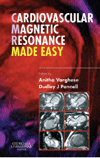Cardiovascular magnetic resonance (CMR) is a safe and accurate imaging modality, with an established role in current cardiology practice. It is becoming essential for cardiologists in other non-imaging sub-specialities to acquire a working knowledge of the potential of CMR in both structural and in ischaemic heart disease. In the current specialist registrar training environment, however, it is difficult to gain that expertise unless wholly committed to an imaging career.
 Editors: Varghese A, Pennell D
Editors: Varghese A, Pennell D
Publisher: Churchill Livingstone Elsevier, 2008
ISBN 978-0-443-10301-8 Price £19.99
This book affords the opportunity to derive a comprehensive overview of this highly technical field in a concise and yet easy-to-read format. Edited by Dr Anitha Varghese and Professor Dudley Pennell, from the Royal Brompton Hospital in London, one of the world’s foremost clinical and academic CMR departments, it also draws upon the experience of a number of international experts.
The first chapter, written by Dr Varghese, introduces the reader to the principles of CMR. It sets the tone of the book with sufficient technical information to introduce the reader to the basics of magnetic resonance imaging with an exhaustive description of the indications for CMR and the associated level of evidence for the assessment of different cardiac pathologies. It serves well as a reference and has well-annotated figures for a visual appreciation of the technique.
All the chapters are well-designed – ischaemic heart disease, heart failure and cardiomyopathy, valvular heart disease, cardiac masses, pericardial disease and myocarditis, the aorta, adult congenital heart disease, and magnetic resonance angiography are all covered sufficiently to give the reader a full overview of the potential of CMR. There is a separate chapter on CMR angiography with an honest caveat on the limitations of the technique compared to invasive angiography, aside from the determination of an anomalous coronary circulation. It would have been helpful to describe the role of CMR angiography in enhancing the diagnosis of vulnerable atherosclerotic plaque, although this indication is largely an academic one at present and not yet in regular clinical practice. The book finishes with a simple description of the common artefacts seen with CMR and how to avoid them in routine practice, again with excellent images presented which are easy to interpret.
In summary, this book is an excellent read and delivers to the reader a full appreciation of the full potential of CMR. It is well written by experts in the field and the quality of the images presented are superb. CMR is truly made easy by Varghese and Pennell and is a worthy addition to this series.
